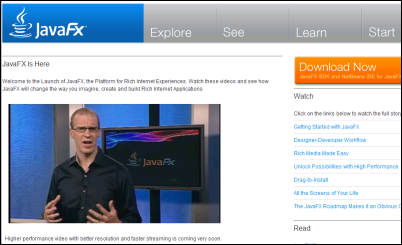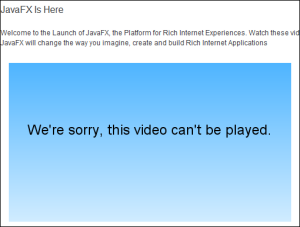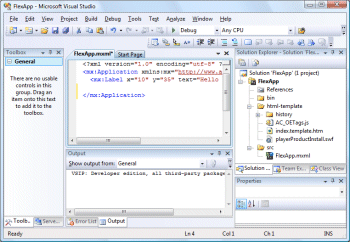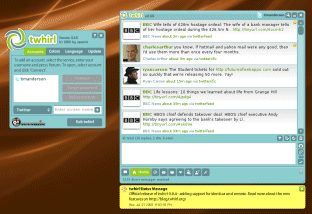Sun has launched JavaFX.

Sun’s Eric Klein, VP of Java Marketing, explains JavaFX
What is it? Sun says:
JavaFX is a rich client platform for building cross-device applications and content. Designed to enable easy creation and deployment of rich internet applications (RIAs) with immersive media and content, the JavaFX platform ensures that RIAs look and behave consistently across diverse form factors and devices.
What is it really? A new script language called JavaFX; a compiler that turns JavaFX script into Java bytecode; a runtime that includes new media codecs; converters that turn SVG, PhotoShop or Illustrator graphics into JavaFX format. JavaFX also requires the JRE (Java Runtime Environment). Currently only Windows and Mac OS X are supported; Linux and Solaris support “will be provided in a future release”; mobile is also on the way, promised for Spring 2009.
A variety of video and audio codecs are supported, but unfortunately these vary by platform. For example, WMV plays only on Windows; H.264 runs on Mac but on Windows only “as an update”, whatever that means. However, there is a specific “cross-platform” codec, which is VP6 from On2. Snag: you need On2’s commercial software to convert to the required .FXM format.
What’s good about JavaFX? Sun claims broadest market reach; but this is nonsense – I presume it is counting every device with a smidgen of Java installed. There are some advantages though. JavaFX can run Java code, and there’s plenty of that out there. The Java VM is mature and fast. A neat feature is that you can run JavaFX applications outside the browser by dragging them onto the desktop. Even in the browser, Java FX are not confined to the browser window, but can create graphics that appear anywhere on the screen. Java SE 6 update 10 or higher is required for these features, which depend on an out of process Java applet plugin in this update.
What’s bad about JavaFX? There are several reasons why Sun will find this a hard sell:
- Large download size. Flash and Silverlight are self-contained browser plug-ins; Silverlight is larger than Flash, but still under 5MB. I’m not sure exactly what size JavaFX is on a machine without Java. I tried visiting javafx.com on a new XP install, and was directed to the main Java download site which recommended a JRE of about 7MB; I suspect it might do further incremental downloads after that, since the full JRE is more like 15MB. Once the JRE is in, you still need to install the JavaFX runtime, though is done automatically and I imagine that in time JavaFX will just be part of the JRE. Right now, the process is less smooth than for Flash or Silverlight.
- Lack of design tools. Adobe has its fantastic Creative Suite, most of which now seems to target Flash. Microsoft has Expression. Sun is offering converters for Photoshop and Illustrator or SVG. These applications know nothing about JavaFX, and there is no visual editor in NetBeans 6.5.
- A new language. Although JavaFX script does not look particularly difficult to learn, it is friction for developers wanting to give it a try.
- Signs of haste. I’m seeing this now. When I saw the JavaFX announcement, I went to the site and successfully installed the runtime and played the introductory video, which itself uses JavaFX. Soon after, presumably as word spread, the launch site became unusable for me. Videos do not play; samples do not download. The spin will be that this shows the high level of interest; but vendors like Sun are meant to understand about scalability.

JavaFX.com showing signs of stress on launch day - Late to the party. Adobe is well entrenched with Flash. If Microsoft is late with Silverlight, Sun is very late with JavaFX.
- Limited features. I’m just back from Adobe MAX, learning about features like Pixel Bender in Flash Player 10, and its new text rendering engine, and new audio API. The JavaFX API looks limited by comparison. There is no 3D support yet.
- Lack of compelling reasons for adoption. You can run Java code; but then again, Java applets and desktop Java clients have been around for many years. I can see the value in both Flash and Silverlight, but what is the must-have feature of JavaFX?
- Platform variation. It bothers me that JavaFX supports different codecs on different platforms. What happened to write once – run everywhere?
What else? It’s early days. I’d like to hear from Designers whether JavaFX does what they need. JavaFX will improve, and it does have obvious value for Java developers who want to code rich internet applications. Sun’s commitment to open source may make JavaFX interesting to those who find Flash and Silverlight too tightly locked to single vendors.
Some details above are drawn from the JavaFX FAQ.

